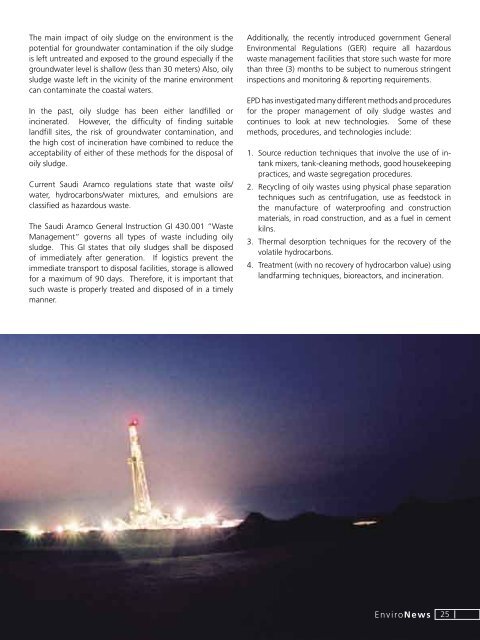Oily Sludge Waste - Saudi Aramco
Oily Sludge Waste - Saudi Aramco
Oily Sludge Waste - Saudi Aramco
Create successful ePaper yourself
Turn your PDF publications into a flip-book with our unique Google optimized e-Paper software.
The main impact of oily sludge on the environment is thepotential for groundwater contamination if the oily sludgeis left untreated and exposed to the ground especially if thegroundwater level is shallow (less than 30 meters) Also, oilysludge waste left in the vicinity of the marine environmentcan contaminate the coastal waters.In the past, oily sludge has been either landfilled orincinerated. However, the difficulty of finding suitablelandfill sites, the risk of groundwater contamination, andthe high cost of incineration have combined to reduce theacceptability of either of these methods for the disposal ofoily sludge.Current <strong>Saudi</strong> <strong>Aramco</strong> regulations state that waste oils/water, hydrocarbons/water mixtures, and emulsions areclassified as hazardous waste.The <strong>Saudi</strong> <strong>Aramco</strong> General Instruction GI 430.001 “<strong>Waste</strong>Management” governs all types of waste including oilysludge. This GI states that oily sludges shall be disposedof immediately after generation. If logistics prevent theimmediate transport to disposal facilities, storage is allowedfor a maximum of 90 days. Therefore, it is important thatsuch waste is properly treated and disposed of in a timelymanner.Additionally, the recently introduced government GeneralEnvironmental Regulations (GER) require all hazardouswaste management facilities that store such waste for morethan three (3) months to be subject to numerous stringentinspections and monitoring & reporting requirements.EPD has investigated many different methods and proceduresfor the proper management of oily sludge wastes andcontinues to look at new technologies. Some of thesemethods, procedures, and technologies include:1. Source reduction techniques that involve the use of intankmixers, tank-cleaning methods, good housekeepingpractices, and waste segregation procedures.2. Recycling of oily wastes using physical phase separationtechniques such as centrifugation, use as feedstock inthe manufacture of waterproofing and constructionmaterials, in road construction, and as a fuel in cementkilns.3. Thermal desorption techniques for the recovery of thevolatile hydrocarbons.4. Treatment (with no recovery of hydrocarbon value) usinglandfarming techniques, bioreactors, and incineration.EnviroNews25
















